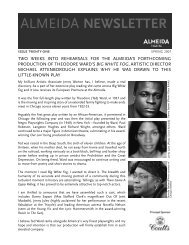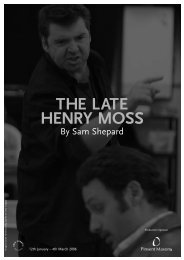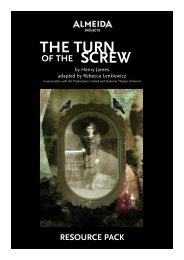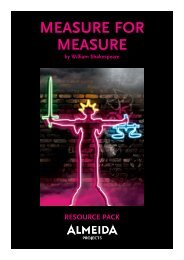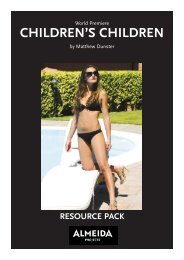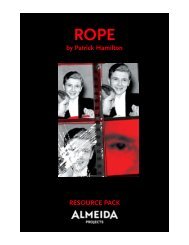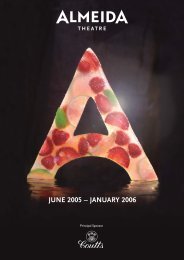to download the production programme as a PDF ... - Almeida Theatre
to download the production programme as a PDF ... - Almeida Theatre
to download the production programme as a PDF ... - Almeida Theatre
Create successful ePaper yourself
Turn your PDF publications into a flip-book with our unique Google optimized e-Paper software.
Duet for One<br />
– <strong>the</strong> talking cure Lisa<br />
Appignanesi<br />
Two people sit alone in a room. One<br />
talks and talks, revealing intimacies.<br />
The o<strong>the</strong>r listens intently, offering up<br />
an occ<strong>as</strong>ional comment or query.<br />
They might be lovers, though <strong>the</strong>y<br />
never quite <strong>to</strong>uch despite <strong>the</strong><br />
presence of a couch. They might be<br />
parent and grown child. Or <strong>the</strong>y<br />
might be patient and analyst.<br />
The technology of <strong>the</strong> talking cure<br />
that Freud invented over a hundred<br />
years ago is in one sense a<br />
simulacrum of a love affair.<br />
Attentiveness <strong>to</strong> every <strong>as</strong>pect of <strong>the</strong><br />
o<strong>the</strong>r, freedom <strong>to</strong> say anything that<br />
comes in<strong>to</strong> your mind without<br />
incurring judgment, revelations about<br />
<strong>the</strong> self and <strong>the</strong> p<strong>as</strong>t seen or lived<br />
afresh through ano<strong>the</strong>r’s eyes, secrets<br />
te<strong>as</strong>ed out, projections on<strong>to</strong> <strong>the</strong> o<strong>the</strong>r<br />
of versions of love learned in<br />
childhood, <strong>the</strong> hope of transformation<br />
– <strong>the</strong>se are common <strong>to</strong> both kinds of<br />
scene. So, <strong>to</strong>o, are fl<strong>as</strong>hes of hatred,<br />
of ‘p<strong>as</strong>sion’, and a resistance <strong>to</strong> <strong>the</strong><br />
views <strong>the</strong> o<strong>the</strong>r may have of one.<br />
All this h<strong>as</strong> made <strong>the</strong> ‘cure through<br />
love’, like love itself, a fertile terrain for<br />
fiction and drama. Hitchcock’s<br />
Spellbound, <strong>the</strong> first film <strong>to</strong> have a<br />
psychoanalyst <strong>as</strong> a script consultant,<br />
collapses love and <strong>the</strong> cure in<strong>to</strong> one:<br />
Ingrid Bergman plays both nurturing<br />
shrink and lover <strong>to</strong> Gregory Peck’s<br />
amnesiac patient, travelling <strong>the</strong> road<br />
in<strong>to</strong> <strong>the</strong> p<strong>as</strong>t <strong>to</strong> unearth <strong>the</strong> buried<br />
secrets which will res<strong>to</strong>re him <strong>to</strong> his<br />
better self. She h<strong>as</strong> her own analyst –<br />
one who comes with an accent and<br />
name which, like Dr Feldmann’s in<br />
Duet for One, stand in for <strong>the</strong> wisdom<br />
of central Europe.<br />
Philip Roth’s famous Dr Spielvogel,<br />
shrink <strong>to</strong> his heroes Portnoy and<br />
Tarnopol, is cut from similar cloth. For<br />
all that Roth’s writer-narra<strong>to</strong>rs may<br />
contest Spielvogel’s interpretations,<br />
just <strong>as</strong> Nabokov’s Humbert Humbert<br />
liked <strong>to</strong> play havoc with <strong>the</strong> minds of<br />
his psychiatrists, <strong>the</strong> shrink remains<br />
<strong>the</strong> (counter) expert on <strong>the</strong> human<br />
soul: he who is ‘supposed <strong>to</strong> know’.<br />
Whe<strong>the</strong>r he knows better or more than<br />
his artist-patients is part of <strong>the</strong> drama<br />
or comedy of what is always a<br />
combative encounter. Truth, after all,<br />
and particularly in our post-modern<br />
times, is hardly single or absolute or<br />
reducible <strong>to</strong> one of <strong>the</strong> many<br />
permutations on an Oedipal <strong>the</strong>me,<br />
whatever its attractions.<br />
Recent fictional versions of <strong>the</strong><br />
shrink have carried far less authority,<br />
let alone certainty, than <strong>the</strong>ir earlier<br />
counterparts. Whe<strong>the</strong>r <strong>the</strong>y’re of <strong>the</strong><br />
medicalizing psychiatric variety or of<br />
<strong>the</strong> softer psycho<strong>the</strong>rapeutic kind, <strong>the</strong>y<br />
emerge <strong>as</strong> fallible and are more<br />
affected than <strong>the</strong>ir older kin by what<br />
goes on in <strong>the</strong> <strong>the</strong>rapeutic hour. Hanif<br />
Kureishi’s Jamal in Something <strong>to</strong> Tell<br />
You is himself in <strong>the</strong> throes of<br />
depression. Al<strong>as</strong>tair Campbell’s<br />
psychiatrist in his debut novel, All in<br />
<strong>the</strong> Mind, suffers a breakdown, while<br />
<strong>the</strong> <strong>the</strong>rapist in <strong>the</strong> hit American<br />
television series, The Treatment,<br />
succumbs <strong>to</strong> <strong>the</strong> ‘cure through love’<br />
mistaking it, against all <strong>the</strong> rules, for<br />
<strong>the</strong> real thing. Any single ‘truth’ about<br />
<strong>the</strong> self <strong>to</strong> be garnered through <strong>the</strong><br />
work of analysis is displaced in <strong>the</strong>se<br />
latter-day encounters by a sense that<br />
<strong>the</strong> best <strong>the</strong>rapy can offer up is a goodenough<br />
s<strong>to</strong>ry about <strong>the</strong> self: one that<br />
<strong>the</strong> patient can live with fruitfully.<br />
4<br />
First performed at <strong>the</strong> Bush <strong>Theatre</strong> in<br />
1980 and moving on for a long West<br />
End and <strong>the</strong>n Broadway run, before<br />
becoming a film with Julie Andrews in<br />
<strong>the</strong> lead, Tom Kempinski’s Duet for One<br />
harks back <strong>to</strong> an older model of <strong>the</strong>



